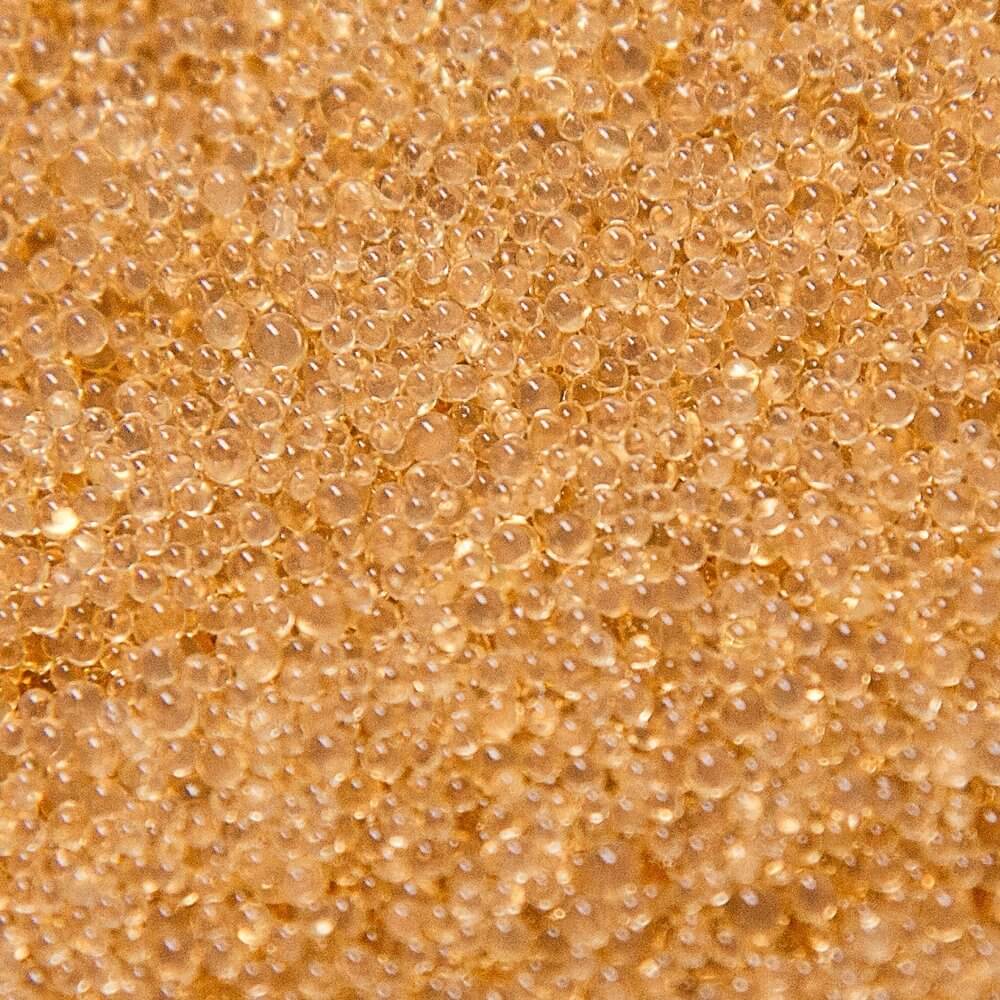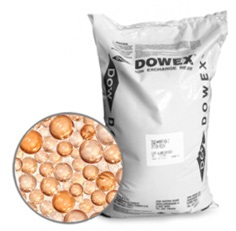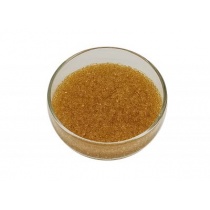Cation exchange resin developed for water softening, which is used for water treatment in cottages, households, food, beverage, energy industries.
Excellent chemical and physical stability, high grain integrity of the resin and very low erasability plays a major role in its successful application.
- Strong acid cation exchange resin
- Grain size range: +1.2 mm <5 %,-0.3 mm <1 %
- Bulk weight 850 g/l
- Layer loosening at backwashing 50-75% of layer height
- Empty space above layer min 75% of layer height
- Swelling from Na+ to H 5 % max. from Ca+ to Na 8 % max.
- Layer height: 51-100 cm
- Moisture content, in Na+ form: 46-50%
- Wet volumetric capacity min 1.9 g*eq/l
- Operating temperature, in Na+ form 150*C max.
- pH of water: 6-10
- pressure loss (4*C) during service at 1m layer height = 12-64 mbar
- pressure loss (4*C) during backwashing at 1m bed height = 38-64 mbar
- suspended solids up to 8 mg/l
- chromaticity up to 30*C
- Na-cationite regeneration is carried out with 10-11% NaC1 solution.
- turbidity up to 6 mg/l
- total hardness up to 15 mg*eq/l
- Side effects: total alkalinity and dry residue will increase.
- absence of oxidized iron (Fe3+) in water
- absence of dissolved oxygen in water
- absence of any oxidizing agents in water
| Operations | speed | solution | minutes | volume |
| Service | 8 до 40 ОС/ч | water | — | — |
| Reverse | per tab 2 | water | 5-20 | 1,4-2,7 ОС |
| Salt | 2-7 ОС/ч | 8-20% NaCl | 15-60 | 60-160 гр/л |
| Water | 2-7 ОС/ч | water | до 30 | 2-4 ОС |
| Straight | 8-40 ОС/ч | water | до 30 | 3,2-6 ОС |
RESIN PROPERTIES
The performance data of C-100E resin in Na+ form depends on:
(a) The amount and concentration of the reagent used.
b) The total hardness of the water and the sodium content of the water.
(c) The rate of water flow through the loading bed.
Performance is usually evaluated in terms of residual hardness in the treated water (traditionally expressed as ppm CaCO3, where 1 ppm CaCO corresponds to a divalent cation concentration of 0.02 mg*eq/L). In water softening, low regeneration levels and high hardness removal efficiency are usually required, since acceptable quality is usually obtained by a bypass in which the fully softened stream is mixed with untreated water.
Condition for juice production, or in food water use, suitable water quality, with less than 5 ppm hardness, can be obtained with a level of 72-80 g salt per 1 L of resin (4.5-5 lb/ft3). Typically, water with low residual hardness levels are not required. The most efficient use of reagent can be achieved. using high salt concentrations and giving adequate contact time; subsequent removal of reagent from the loading bed should also be slow, but final removal of additional salt should be done normally.
The slip of hardness salts is usually less than 1% of the total hardness of the treated water, unless the raw water contains more than 25% of its exchangeable cations as sodium (or other univalent) ions. The operating capacity and average hardness slip during service can be calculated according to Tables 3 through 6.
HYDRAULIC CHARATERISTICS:
The pressure loss of the ion exchange resin depends on the particle size distribution, the depth of the loading bed, and the free volume of the cylinder, on the flow rate and viscosity (and hence temperature) of the water to be treated. Any of these parameters, such as the presence of a macroparticle in the loading bed or improper sealing of the loading bed will affect the pressure drop. Typical pressure drop variations of C-100E resin are given in Figure 1 for a range of operating flow rates.
During bottom-up backwashing, the feed bed should be expanded in volume between 50 and 75%. This is necessary to remove macroparticles from the resin, clean the load from bubbles and voids, and reconstitute the resin to the maximum extent possible, ensuring minimum drag. Backwashing should be started gradually to avoid hydrostatic shock. Load expansion increases with flow rate and with decreasing temperature. Care must be taken to avoid washing away the resin by over-expansion of the bed. 1 m/h = 0.409 gvm/ft2 1 kg/cm2 per 1 m layer thickness = 4.33 psi/ft
CHEMICAL AND THERMAL STABILITY
C-100E resin is insoluble in dilute or moderately concentrated acid, alkali and all common solvents. However, exposure to substantial amounts of free chlorine, hypochlorite ions, or other strong oxidizing agents degrades the resin. This leads to a tendency to increase the moisture content of the resin, reducing its mechanical strength. Resins are heat stable up to 150*C in alkali (e.g. sodium) or alkaline earth (calcium and magnesium) salts. The free acid form tends to hydrolyze in water at temperatures markedly higher than 120*C, losing bulk capacity as functional groups are gradually replaced by hydroxyl groups.
HOW TO CALCULATE RESIN VOLUME?
If the salt dosage, source water analysis and flow rate at service are known, the working capacity and hardness salt slip can be calculated. See example:
EXAMPLE:
capacity calculation: using 3 tables: 75 g salt/l = 1.05 g*eq/l
| source water: | rrm | мг*экв/л | according to 4 tables: tds at 500 and servo speed 40m/h = 0.96 |
| overall stiffness: | 400 | 8 | 1,05*0,96 = 1 |
| sodium | 100 | 2 | 1*90% = 0.9 mg*eq/L |
| TDS | 500 | 10 | slip calculation |
| regeneration: | 75гр соли/л например | tabs: 75g/L = 5rms CaCO3 slip. | |
| speed of service: | скорость от 8 до 40 м/ч | according to 6 tables: tds at 500 = 1.1 | |
| 5*1.1=5.5 rpm of CaCO3 slip |
Thus, the main advantage of ion exchange in water purification from iron – both iron and manganese in dissolved state are removed from water. There are some limitations on the use of ion exchange in water treatment of iron:
Cationites are rationally used in cases where water hardness is high, as iron is removed along with the hardness. If the water hardness is moderate and water softening is not required, the use of cationic ion exchange resins is not rational. Ion exchange resins react negatively to the presence of trivalent iron in water, which clogs the resin and is not washed out of it.
Thus, ion exchange for water purification from iron is used in the absence of oxidized iron, dissolved oxygen, oxidants in water, with a limited range of pH. Limited use at higher concentrations of iron, because there is a high probability of formation of trivalent iron, much faster depletes the filtering ability of ion exchange resin, which leads to an increase in salt consumption with frequent regenerations, which makes the water treatment system is not profitable.
Organic matter leads to overgrowth of the resin with an organic film, which is a breeding ground for bacteria. Despite these limitations, the use of ion exchange resins in water treatment is a promising direction in water purification from iron and manganese. The main task is to select a multi-component combination of resins, which will be effective in this or that case.
To buy ion exchange resin Purolite C-100E in Odessa, Kiev, Kharkov, Dnipro call 097-26-33-100 or fill out the form below, and we will contact you within 30 minutes.





